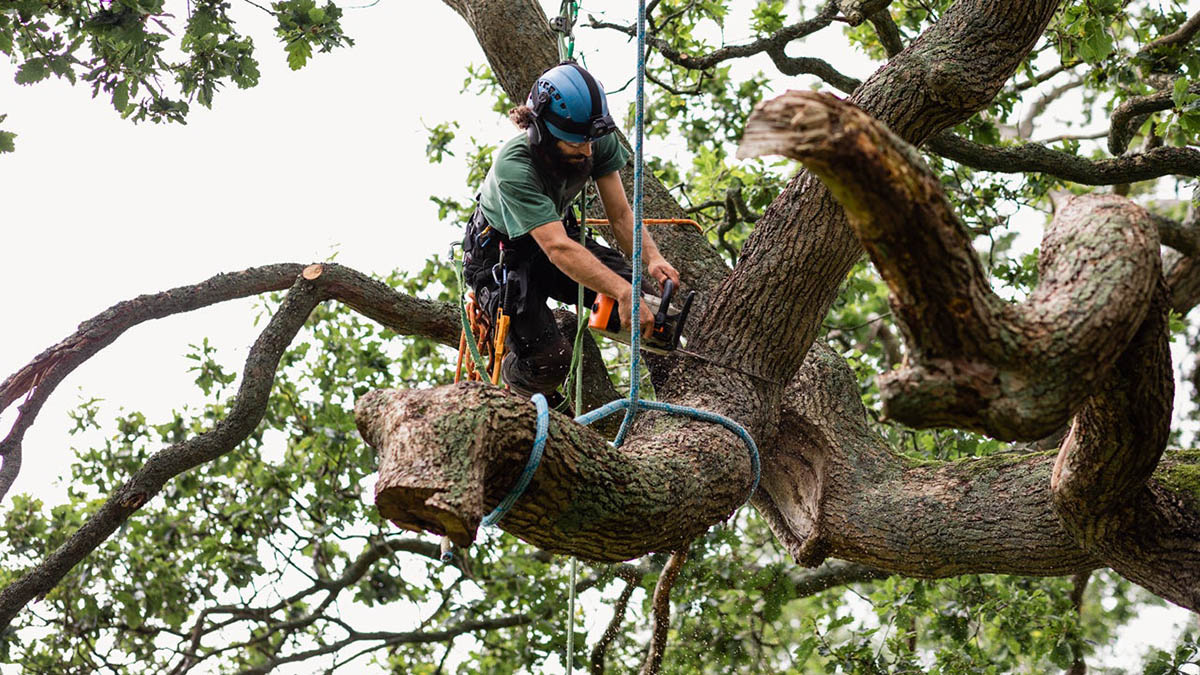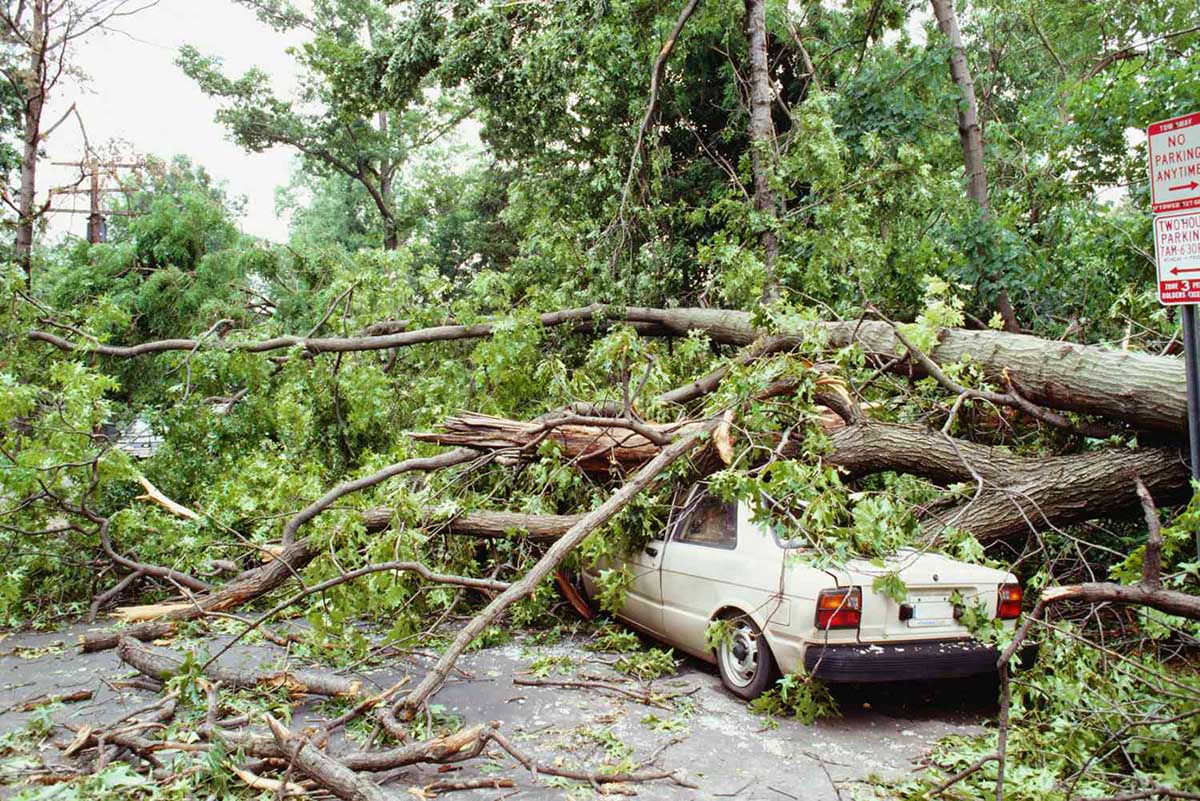

Finance
How Much Is Tree Service Insurance?
Published: November 16, 2023
Find out the cost of tree service insurance and protect your finances. Get the coverage you need to safeguard your business.
(Many of the links in this article redirect to a specific reviewed product. Your purchase of these products through affiliate links helps to generate commission for LiveWell, at no extra cost. Learn more)
Table of Contents
Introduction
Welcome to our comprehensive guide on tree service insurance. As a tree service contractor or business owner, it’s crucial to understand the importance of having the right insurance coverage to protect your business, employees, and clients. Whether you specialize in tree removal, trimming, or maintenance, the nature of your work involves potential risks and liabilities that can result in financial losses if not properly addressed.
In this article, we will delve into the world of tree service insurance, exploring the various types of coverage available, factors that affect insurance costs, and provide tips on how to find affordable insurance options. Our goal is to empower you with the knowledge you need to make informed decisions about your insurance needs, ensuring you have the right coverage at a price that fits your budget.
Running a tree service business is not without its challenges, from handling heavy machinery to working at heights and dealing with unpredictable weather conditions. Accidents can happen, including property damage, bodily injuries, or even a legal dispute with a client. Without the appropriate insurance coverage in place, these situations can financially cripple your business and put its reputation at risk.
Tree service insurance provides protection against such risks, offering coverage for property damage, bodily injury, product liability, and general liability, among other potential incidents. By partnering with an insurance provider that specializes in tree service industry coverage, you can ensure that your business is protected against unforeseen events and potential legal claims.
It is important to note that the specific insurance requirements for tree service businesses may vary depending on your location, the type of services you offer, and the size of your operations. Local regulations and client contracts may also dictate certain insurance coverage prerequisites. Therefore, it is crucial to consult with an insurance professional who understands the needs of the tree service industry and can provide personalized recommendations based on your unique circumstances.
In the following sections, we will explore the different types of tree service insurance coverage available and the factors that can influence insurance costs. Armed with this knowledge, you will be better equipped to navigate the insurance landscape and secure coverage that safeguards your business and provides you with peace of mind.
Understanding Tree Service Insurance
Tree service insurance is a specialized type of insurance that is designed to protect tree service businesses from the various risks and liabilities associated with their operations. It provides coverage for property damage, bodily injury, legal expenses, and other potential accidents or incidents that may occur during tree service-related activities.
There are several types of insurance coverage that are typically included in a comprehensive tree service insurance policy:
- General Liability Insurance: This coverage protects your business against third-party claims for bodily injury or property damage. It can cover medical expenses, legal fees, and court-awarded judgments if you are found liable for causing harm to someone or damaging their property.
- Commercial Property Insurance: This coverage protects your physical assets, such as equipment, tools, office space, and storage facilities, against damage or loss caused by fire, theft, vandalism, or natural disasters.
- Commercial Auto Insurance: If your business owns vehicles that are used for tree service operations, commercial auto insurance provides coverage for damages or injuries resulting from accidents involving these vehicles.
- Workers’ Compensation: This coverage is essential if you have employees. It provides medical expenses, lost wages, and rehabilitation costs if an employee is injured on the job.
- Equipment and Tool Insurance: This coverage protects your tree service equipment and tools against damage, theft, or loss.
- Professional Liability Insurance: Also known as Errors and Omissions (E&O) insurance, this coverage is important if you provide professional advice or consultation as part of your tree service operations.
Having appropriate tree service insurance coverage is crucial because it helps protect your business from unforeseen circumstances and potential financial liabilities. A single accident or lawsuit can lead to significant financial losses and even the closure of your business if you are not adequately insured.
When obtaining tree service insurance, it is important to carefully review your policy to understand what is covered and any exclusions or limitations. Every insurance policy may have unique terms and conditions, so it’s essential to work closely with an insurance professional who understands the specific needs of tree service businesses. They can help tailor a policy that adequately covers the risks associated with your operations.
Furthermore, it’s important to periodically review your insurance coverage as your business grows or if there are any changes in your operations. This will ensure that you have the appropriate level of coverage to protect your assets and mitigate potential risks.
Types of Coverage
Tree service insurance provides various types of coverage to protect your business from the risks and liabilities associated with your operations. Understanding the different types of coverage that are available can help ensure that you have the right insurance policy in place. Here are some essential types of coverage commonly included in tree service insurance:
- General Liability Insurance: This coverage is essential for tree service businesses, as it protects against third-party claims for bodily injury or property damage. Whether it’s a client’s property getting damaged during tree removal or a person getting injured by falling branches, general liability insurance provides coverage for medical expenses, legal fees, and potential court-awarded damages.
- Commercial Property Insurance: This coverage protects your business’s physical assets, such as equipment, tools, and storage facilities, in case of damage or loss due to fire, theft, vandalism, or natural disasters. It provides financial compensation to repair or replace damaged property, ensuring that your business can continue its operations smoothly.
- Commercial Auto Insurance: If your tree service business owns vehicles that are used for transportation or hauling purposes, commercial auto insurance is essential. It covers damages or injuries resulting from accidents involving your business vehicles, including both owned and leased vehicles, and helps protect your business from legal liabilities.
- Workers’ Compensation: If you have employees working for your tree service business, workers’ compensation insurance is crucial. It provides coverage for medical expenses, lost wages, and rehabilitation costs if an employee suffers work-related injuries or illnesses. Workers’ compensation insurance not only protects your employees but also safeguards your business from potential lawsuits related to workplace injuries.
- Equipment and Tool Insurance: Tree service businesses rely on specialized equipment and tools to carry out their operations. Equipment and tool insurance provides coverage for repairs or replacements in case of damage, theft, or loss of these valuable assets. This coverage helps ensure that your business can promptly replace damaged or stolen equipment and continue its operations without significant disruptions.
- Professional Liability Insurance: Also known as Errors and Omissions (E&O) insurance, professional liability coverage is essential if your tree service business provides professional advice or consultation. It protects against claims or lawsuits arising from errors or negligence in the advice or services provided. Professional liability insurance provides financial protection for legal defense costs, settlements, or judgments, safeguarding your business’s reputation and financial stability.
It’s important to evaluate your specific business needs and the risks associated with your tree service operations when selecting the types of coverage for your insurance policy. Working closely with an insurance professional who specializes in tree service industry coverage can help ensure that you have a comprehensive policy that adequately covers your business from potential risks and liabilities.
Remember, each insurance policy may have unique terms, conditions, and coverage limits, so take the time to review and understand the details of your policy to ensure you have the right coverage in place.
Factors That Affect Insurance Costs
When it comes to tree service insurance, the cost of coverage can vary depending on several factors. Understanding these factors can help you get a better idea of what influences insurance premiums and how to manage your insurance costs effectively. Here are some key factors that can affect the cost of tree service insurance:
- Type of Coverage: The types of coverage you choose for your tree service insurance policy will have a direct impact on the cost. Insurance policies with comprehensive coverage that includes general liability, commercial property, commercial auto, and workers’ compensation typically have a higher premium compared to policies with fewer coverage options.
- Business Size and Revenue: The size of your tree service business, in terms of revenue and number of employees, can affect your insurance costs. Larger businesses with higher revenues and more employees generally face higher insurance premiums due to the increased exposure to risks and potential liabilities.
- Claims History: Insurance companies consider your past claims history when determining your premiums. If your business has a history of frequent or severe claims, it may result in higher insurance costs. On the other hand, a clean claims history can help lower your premiums by demonstrating that your business is low-risk and operates safely.
- Location: The location of your tree service business can also impact insurance costs. Insurance providers take into account the local climate, environmental risks, and the prevalence of lawsuits in your area when determining premiums. Businesses located in areas with higher risk factors may face higher insurance costs.
- Experience and Expertise: Insurance companies may consider the experience and expertise of the tree service professionals in your business. Businesses with experienced and well-trained employees may be viewed as lower-risk, leading to potentially lower insurance costs.
- Safety Measures: Implementing strong safety protocols and maintaining a safe work environment can help reduce your insurance costs. Insurance providers often offer discounts to businesses that have robust safety programs, including regular training for employees and proper maintenance of equipment.
- Deductible Amount: The deductible is the amount you agree to pay out of pocket before your insurance coverage kicks in. Choosing a higher deductible can lower your insurance premiums, but it also means that you will have to cover more expenses in the event of a claim.
It’s important to note that the specific impact of these factors on your insurance costs may vary depending on the insurance provider and other individual factors. It’s advisable to work closely with an insurance professional who can assess your specific business needs and identify ways to help manage your insurance costs without compromising on coverage.
Regularly reviewing your insurance policies and shopping around for competitive quotes can also help you find the best coverage at the most affordable price. Insurance premiums can vary significantly between providers, so it’s worth comparing multiple options to ensure you are getting the best value for your insurance investment.
Average Cost of Tree Service Insurance
The cost of tree service insurance can vary depending on several factors, including the size of your business, the types of coverage you need, location, claims history, and other individual factors. While it is difficult to provide an exact figure for the average cost of tree service insurance, we can give you a general idea based on industry trends and common coverage needs.
On average, tree service insurance premiums can range from $1,000 to $5,000 per year for small to medium-sized businesses. However, keep in mind that this range is just an estimate, and your actual costs may be higher or lower depending on your specific circumstances.
Factors such as the number of employees, annual revenue, coverage limits, and deductibles will all affect your premium costs. If your business has a history of claims, you may also experience higher premiums due to an increased perception of risk by insurance providers.
The types of coverage you choose will also impact the cost. A policy with general liability, commercial property, commercial auto, workers’ compensation, equipment and tool insurance, and professional liability coverage will naturally have a higher premium compared to a policy with a more limited scope of coverage.
It’s important to note that exact pricing will be determined by insurance providers after doing a thorough assessment of your business and its specific risk factors. Insurance providers will take into consideration your location, the type of services you offer, the value of your equipment, and other relevant factors to determine your premium costs.
To get an accurate idea of the cost of tree service insurance for your business, it is crucial to reach out to insurance providers that specialize in the tree service industry. By providing them with detailed information about your business and its specific needs, they can provide you with customized quotes tailored to your unique circumstances.
Remember, while price is an important factor, it shouldn’t be the sole consideration when choosing insurance coverage. It’s essential to strike a balance between cost and coverage to ensure that your business is adequately protected.
Working with an insurance professional who understands the tree service industry can be invaluable in helping you navigate the insurance landscape, identify your coverage needs, and find an insurance policy that provides comprehensive protection at a competitive price.
Tips for Finding Affordable Insurance
Securing affordable insurance coverage for your tree service business is essential to protect your assets and mitigate potential risks. Here are some tips to help you find affordable insurance options without compromising on coverage:
- Shop Around: Don’t settle for the first insurance quote you receive. Take the time to shop around and compare multiple insurance providers. Each company may offer different coverage options and pricing, so exploring your options can help you find the best value for your insurance investment.
- Work with a Specialist: Look for insurance providers or agents who specialize in tree service insurance. These professionals have a deep understanding of the industry’s unique risks and can offer tailored coverage options at competitive prices.
- Assess Your Coverage Needs: Evaluate your specific coverage needs and risks before purchasing insurance. By understanding the type and amount of coverage required for your business, you can avoid overpaying for unnecessary coverage while ensuring your business is adequately protected.
- Consider Bundling: Inquire about potential discounts that may be available for bundling multiple insurance policies, such as general liability, commercial auto, and commercial property insurance. Bundling your policies with the same provider can often result in reduced premiums.
- Focus on Loss Prevention: Implementing strong safety measures and maintaining a clean claims history can help lower your insurance costs. Insurance providers offer incentives and discounts to businesses that prioritize loss prevention through regular safety training, equipment maintenance, and proactive risk management.
- Review and Update Policies Regularly: As your business evolves and grows, it’s important to review your insurance policies periodically. Make sure your coverage aligns with your current needs and adjust it if necessary. This will help ensure that you have adequate coverage while avoiding paying for unnecessary or redundant coverage.
- Raise Deductibles, If Feasible: A higher deductible can lower your insurance premiums. However, carefully consider your financial situation and ability to pay the chosen deductible in the event of a claim. It’s essential to strike a balance between premium costs and your ability to cover potential out-of-pocket expenses.
- Seek Professional Guidance: Working with an insurance professional who specializes in tree service insurance can be immensely helpful. They can assess your unique business needs, guide you through the insurance selection process, and recommend appropriate coverage options that suit your budget.
Remember, while finding affordable insurance is important, it is equally crucial to ensure that you have adequate coverage to protect your business from potential risks. A balance between cost and coverage is essential to safeguard your assets and promote long-term business success.
By following these tips and working closely with an insurance professional, you can find affordable insurance options that provide the peace of mind and protection your tree service business needs.
Conclusion
Tree service insurance is a critical component for protecting your tree service business from potential risks and liabilities. It provides coverage against property damage, bodily injury, legal expenses, and other incidents that may occur in the course of your operations. With the right insurance coverage, you can have peace of mind knowing that your business is protected financially, allowing you to focus on providing high-quality services to your clients.
Understanding the types of coverage available, the factors that affect insurance costs, and implementing strategies to find affordable insurance options are key in securing the proper coverage for your tree service business. By shopping around, working with specialists, assessing your coverage needs, and having a proactive approach to loss prevention, you can find the insurance coverage that meets your specific business requirements at a competitive price.
Regularly reviewing and updating your insurance policies as your business grows and evolves is essential to ensure that your coverage remains adequate. Consulting with an insurance professional who specializes in tree service industry coverage can provide valuable insights and guidance throughout the insurance selection process.
Remember, finding affordable insurance should not mean compromising on coverage. It’s crucial to strike a balance between cost and protection, ensuring that your business is adequately covered from potential risks and liabilities.
Protecting your business with tree service insurance is an investment in the long-term success and resilience of your operation. By taking the time to understand your insurance needs, exploring coverage options, and partnering with the right insurance provider, you can minimize financial risks and focus on delivering exceptional tree service to your clients.
Take the necessary steps today to secure the appropriate insurance coverage for your tree service business. Your business and peace of mind will thank you for it in the future.














